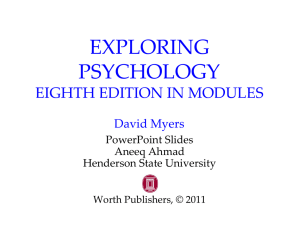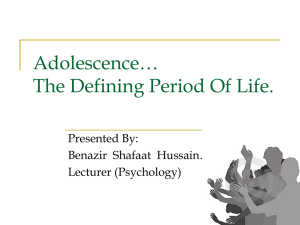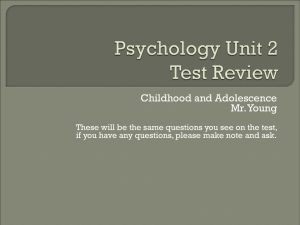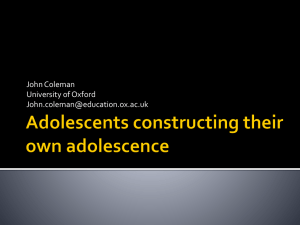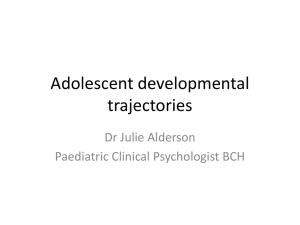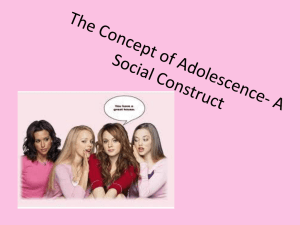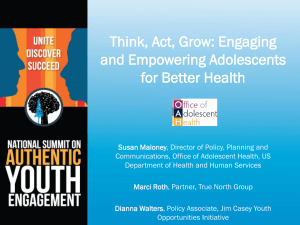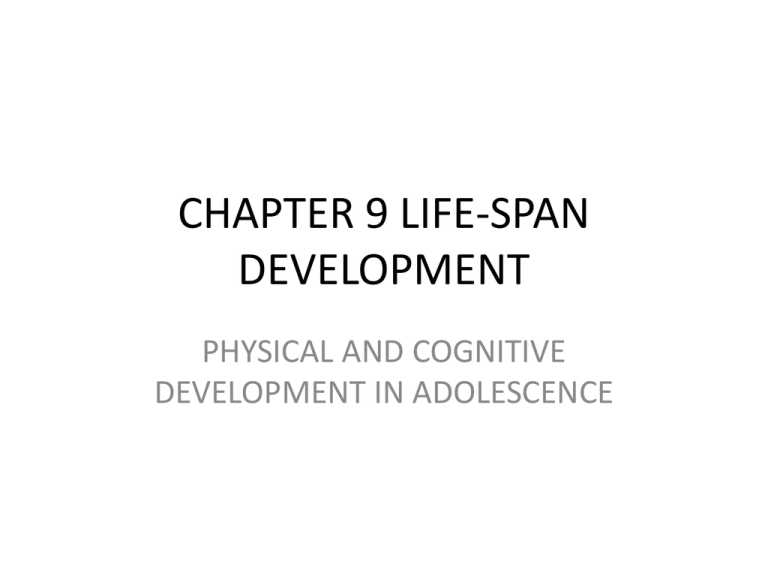
CHAPTER 9 LIFE-SPAN
DEVELOPMENT
PHYSICAL AND COGNITIVE
DEVELOPMENT IN ADOLESCENCE
1. What is the nature of
adolescence?
• Dramatic biological changes
• Relationships with parents, peers and teachers
change
• Thoughts become more abstract and idealistic
• Most adolescents make transition to adult life
successfully
• Many do not because of too few opportunities
and lack of support
2. What physical changes do we
experience in adolescence?
•
•
•
•
Puberty: period of rapid physical maturation
Includes hormonal and bodily changes
Usually early in adolescence
Order of physical changes for males and
females in puberty -- GEC opportunity
3. What hormonal changes occur in
adolescence?
• Hormones: chemicals secreted by endocrine
glands
• Carried throughout body using blood stream
4. Which endocrine glands are
involved in adolescent changes?
• Hypothalamus, pituitary and gonads
• Hypothalamus = structure in the brain
controlling eating and sexual behavior
• Pituitary = brain structure controlling growth
and regulating other glands
• Gonads = testes in males and ovaries in
females
5. Which hormones dominate in males
and females during puberty?
• Testosterone in males affects height and voice
change
• Estradiol (form of estrogen) in females affects
changes in breasts, uterus and skeletal system
• Both hormones are present in both boys and
girls
6. What are other influences on changes in
adolescent physical development?
• Social factors contribute to changes
• Stress, eating patterns, exercise, sexual
activity tension and depression also affect
hormonal levels
7. When does puberty begin?
• For boys = as early as 10 and as late as 13 ½
• For girls = sometime between ages 9 and 15
• Specific time influenced by nutrition, health,
and other environmental factors
8. What are influences on body image
changes in adolescence?
• Adolescents more likely preoccupied with
bodies than other age groups
• Girls tend to be less satisfied than boys, in
general
9. How does brain develop during
adolescence?
• Corpus callosum thickens - improving ability
to process information
• Amygdala ( influences emotions, especially
anger) matures earlier than prefrontal cortex
• Adolescents capable of strong emotions
• Prefrontal cortex not developed enough to
control emotional expressions
10. How does sexual identity develop
during adolescence?
• Involves learning to manage sexual feelings,
developing new forms of intimacy, learning
skills to regulate sexual behavior
• Sexual identity involves activities, interests
and behavior styles
• Sexual orientation develops during this time
also
• Wide variety in tendency toward sexual
activity
• May be influenced by religious and other
values
• Development of gay and lesbian preferences
may be characterized by same-sex attractions
in childhood, lack of heterosexual dating, and
recognition of sexual orientation in mid- to
late adolescence
• Other adolescents may experience both samesex and other-sex attractions
11. What are sexually transmitted
infections?
• Diseases associated with sexual activity
• Not prevented by use of contraceptives, such
as birth control pills or implants
• Examples: HIV-AIDS, gonorrhea, syphilis,
chlamydia (- further discussion in chapter
11)
12. Why is adolescent pregnancy a
concern?
• In US - highest rate of adolescent pregnancy
and childbearing among industrialized
countries
• Rate of pregnancy and childbearing in US
decreased since 1991, because of increased
contraceptive use and fear of STIs, such as
AIDS
• Adolescent pregnancy associated with risk for
mother and baby
• Often mother drops out of school
• Usually mother never catches up economically
with women who postpone childbearing
• Risk for rapid subsequent pregnancies
• Infants have higher risk of low birth weight
and neurological problems
• Pregnancy alone not associated with negative
consequences
• Adolescent mothers likely from low-SES
families
• Adolescent pregnancy in general is high-risk
circumstance
• Support for adolescent mothers is important
in assisting educational and occupational
opportunities
13. What are issues important in
adolescent health?
• Nutrition and exercise affect quality of health
• Poor nutrition and low-level exercise major
contributors to obesity in adolescence
• Problems with nutrition and health can lead to
poor health habits and early death in adult life
• Sleep patterns also contribute to general
health in adolescence
• Inadequate sleep associated with fatigue,
sleepiness, irritability, depression and
increased use of beverages containing caffeine
• Increased sleepiness during the day in older
adolescents associated with changing
biological rhythms
14. What are major causes of death in
adolescence?
• Accidents (Risky driving habits (speeding
and tailgating, driving under influence of
alcohol or drugs)
• Homicide (especially among African-American
male adolescents)
• Suicide ( discussed further in chapter 10)
15. How do parents, peers and school
environment affect substance use and abuse in
adolescence?
• Special concern for children who begin use in
early adolescence or childhood
• Person who begins drinking before age 14
more likely to become alcohol dependent
than peers who wait
• Positive relationships with parents and others
associated with lower probability to have
substance use problems
16. What are 2 eating disorders
affecting adolescent development?
• Anorexia nervosa = obsession with being thin
associated with starvation
• Symptoms = (1) weighing less than 85% of
normal weight for height and bone size;
• (2) intense fear of gaining weight;
• (3) having distorted body image
• Anorexia nervosa usually begins in early to
middle adolescence
• Most people affected are young, white
individuals in adolescence or early adulthood
• Usually from middle-class, well-educated
families
• Set high standards, feel stress about not
meeting standards and obsessed about how
others perceive them
• Bulimia nervosa = individual consistently
follows a binge-and-purge pattern
• Consumes large amounts of high-calorie food
followed by purging through vomiting or use
of laxatives
• Preoccupied with food, strong fear of being
overweight, experience depression and
anxiety
17. How does Piaget’s theory describe cognitive
development during adolescence?
• Piaget believed the formal operational stage of
cognitive development begins during adolescence
• Formal operational stage associated with ability
to think more abstractly
• No longer limited to actual experiences to anchor
thinking
• Increased ability to develop make-believe
situations, abstract propositions and hypothetical
situations
• Example in verbal problem-solving ability
• Formal operational thinker can think through
the process involving A, B, and C and
understand that if A=B and B=C, then A=C
without actually seeing concrete examples of
A,B, and C
• Another example is ability to think about
thinking ( metacognition and considering
the nature of thought)
• Adolescents also display idealism and concern
with possibilities
• Speculate about ideal characteristics and
qualities
• Can lead to comparison with others in light of
these ideal qualities
• Adolescent formal operational thinkers begin
to use hypothetical-deductive reasoning
• Creating a hypothesis and deducing
implications and possible consequences
• Also develop ways to test hypotheses
18. What criticisms have been applied
to Piaget’s ideas?
• GEC possibility
19. What is adolescent
egocentrism?
• Heightened self-consciousness
• 2 key components:
• (1) imaginary audience = belief that others are
as interested in them as they themselves are
• Associated with attempts to gain attention by
others
• and
• (2) personal fable = associated with sense of
uniqueness and invincibility or invulnerability
• Can lead to risky behaviors and believing that
nothing bad will happen as a result
20. How does information processing theory
describe cognition during adolescence?
• Most important change in adolescent thinking
is improved executive functioning
• Involves reasoning, decision-making,
monitoring critical thinking, and monitoring
thinking progress
• Improved executive functioning leads to more
effective learning, improved use of attention
and critical thinking
21. How does decision making change
during adolescence?
• Increased time in decision-making – concerning
friends, dating, possibility of sex, plans for the
future
• Adolescents, more so than children, can generate
different options, evaluate them, anticipate the
consequences and consider source credibility
• Ability to make good decisions not always
associated with actually carrying them out in a
specific life situation ( example, driving)
22. How does critical thinking change
during adolescence?
• Increases with age
• Not as frequent as might be expected in late
adolescence
• If fundamental skills (literacy and math) are
undeveloped, critical thinking skills also likely
to be immature
• Improved critical thinking allows 4 benefits
23. Benefits of improved critical
thinking
• (1) increased speed and automaticity
• (2)increased breadth of content knowledge in
variety of domains
• (3) increased ability to construct new
knowledge combinations
• (4)greater range and more spontaneity of
using strategies for obtaining and applying
knowledge
24. What are characteristics of how schools
influence adolescent development?
• First year of transition can be difficult
• Transition occurs at same time adolescents are
experiencing physical, emotional and social
changes
• Adolescents may experience the top-dog
phenomenon
• Moving from being biggest, oldest and most
experienced to being youngest, smallest and
least powerful
25. What recommendations have been made to create
effective educational environments for young
adolescents?
• GEC possibility
26. What are concerns about the high school
experience affects adolescent development?
• Criticism that high schools encourage passivity
• Recommendation that schools create variety
of paths to develop secure identity
• Concern that many students graduate with
deficient reading, writing and math skills
• Increased concern about high school drop
outs
27. What is service learning?
• Form of education promoting social
responsibility and service to community
• Encourages activities such as tutoring, helping
older adults and assisting at child care centers
• Can lead to decrease in being self-centered
and more motivated to help others
28. What are 2 conditions that make
service learning more effective?
• (1) giving students a degree of choice as to the
service learning activity they participate in
• (2) providing students with opportunities to
reflect on their service learning experiences
• Have resulted in higher grades, increased goalsetting and higher self-esteem and improved
sense of making a difference in the lives of
others
CHAPTER 10
Socioemotional Development in Adolescence
1. What is identity?
•
•
•
•
•
•
Self-portrait
Career and work path
Political identity
Religious identity
Relationships
Achievement and intellectual identity
•
•
•
•
•
Sexual identity
Cultural and ethnic identity
Hobbies and interest
Personality
Physical identity
2. Erikson’s view
• 5th developmental stage
• Psychological moratorium
• -- gap between childhood security and adult
autonomy
• Free to try out new identities
• Experimentation to find place in the world
3. Developmental changes
•
•
•
•
•
Continuous during adolescence
Begins with attachment
Sense of self
Emergence of independence
Final phase with life review in old age
• Late adolescence - physical, cognitive and
socioemotional development allows
synthesizing and constructing adult maturity
• 4 stages of identity-
• Diffusion – not yet experience crisis or make
commitment
• Foreclosure – make a commitment but not
experience crisis; especially with authoritarian
parenting style
• Moratorium – experiencing crisis with no
commitment
• Achievement – past crisis and has made an
identity commitment
4. Beyond Erikson
• Key changes in identity may occur in early
adult life – 18-25 years
• MAMA cycle possible during adult life –
moratorium and achievement alternation
5. Family influences
• Individuality has 2 dimensions
• - self-assertion, when you have and
communicate a point of view
• - separateness, using communication to
express difference from others
• Connectedness also has 2 dimensions
• - mutuality, or sensitivity to and respect for
others
• - permeability, openness to others’ views
• Identity formation supported by family
relationship characterized by
• Individuation, encouraging adolescent to
develop an independent point of view
• Connectedness, providing secure base for
exploring
• Strong connection and weak individuation
results in identity foreclosure
• Weak connection leads to identity confusion
6. Ethnic identity
• Includes sense of membership in an ethnic
group
• Also attitudes and feelings associated with
ethnic membership
• If member of ethnic minority, can choose
among 2+ sources of identity
• May develop bicultural or multicultural
identity
7. Autonomy and attachment
• Parents may have difficulty coping with
adolescent’s search for autonomy and
responsibility
• Adolescent ability to gain control of behavior
develops best if adult support is appropriate
• Wise adults gradually allow adolescent to
make mature decisions on their own
8. Role of attachment
• Securely attached adolescents less likely to
engage in problem behaviors such as illegal
drug use and delinquency
• Also more likely to have positive peer
relationships
• Caution: moderate correlations
9. Parent-Adolescent conflict
• Most conflict experienced in everyday
situations
• Conflict may increase in early adolescence,
stabilize in mid-adolescence and decrease in
late adolescence
• Every day conflict can serve positive
developmental function
• Transition to increasing independence
• Old model-
• Suggest adolescents detach from parents as
they mature
• High stress and intense conflict
• New model-
• Parents are important attachment source and
support system
• Moderate conflict
10. Competent adolescent have
parents who:
• Show warmth and respect
• Demonstrate sustained interest
• Understand and adapt to cognitive and
socioemotional changes
• Communicate expectations for high standards
• Recognize moderate conflict is normal
• Demonstrate constructive ways to resolve
problems
• Understand the developmental journey
11. Peers
• Friendships-
• In adolescence, fewer friendships and more
intense and intimate
• More important
• Failure to develop intimacy can lead to
loneliness and depression with reduced sense
of self-esteem
• Young adolescents more influenced my peer
pressure
• Cliques – small groups, usually same sex and
same age, may develop from club or sport
activities
• Crowds – larger and less personal,
membership based on reputation
– Defined by activities and level of self-esteem
12. Developmental changes in
dating
• Usually 10th to 12th grade before relationships
last more than 2+ months
• Early adolescents usually gather in groups for
social acitivites
• Cyberdating can begin in middle school
– Hazardous
– Declines in high school when real-life relationships
more important
13. Gay and lesbian dating
• May go out with same-sex peers to clarify
sexual identity or disguise it
• Relatively rare in adolescence because of few
opportunities and social disapproval
14. Cross-cultural comparisons
• Variations in adolescent behavior
– 2/3 Asian Indian adolescents accept parent choice
of marital partner
– Philippines, many female adolescents migrate to
city to work and support families
– Middle East, adolescents do not interact with
peers, even in school
• Street youth in Kenya and other countries, if
abandoned by parents engage in delinquency or
prostitution to survive
15. Health
• Improved in some areas and not in others
• Few adolescents die from infectious diseases
and malnutrition
• Increased health-risky behaviors such as drug
use and unprotected sex
16. Gender
• In many countries outside US, males have
greater access to educational opportunities
• Females usually have less freedom to pursue
variety of careers and engage in leisure
activities
• Especially in Southeast Asia, Latin America and
Arab countries – more restrictions on sexual
activities of adolescent females
17. Families
• In some countries outside US, close-knit
families and extensive extended family
networks
• In US, parenting usually less authoritarian
– More adolescents grow up in divorced families or
step-families
18. Peers
• Cultural differences in peer influences
– South American street youth peers can serve as
substitute family for survival
19. Ethnicity
• Immigration- high rates contribute to growing
cultural minorities in US
• Characterized by stressors uncommon for
native residents
– Language barriers
– Dislocations and separation from support
networks
– Change in SES status
– Dual struggle to maintain identity and acculturate
• Assimilation – absorption of ethnic minority
groups into dominant culture
– May mean loss of behaviors and values from
ethnic minority group
• Pluralism –
– Coexistence of distinct cultural and ethnic groups
in same society
20. Ethnicity and socioeconomic
status
• May interact in ways that exaggerate
influence of ethnicity
• Ethnic minorities overrepresented in lower
SES groups
• Poverty adds to stress of ethnic minority
adolescents
• Double disadvantage :1) prejudice,
discrimination and bias because of ethnic
minority status
• 2) stressful effects of poverty
21. Juvenile delinquency
• Breaking the law or engaging in illegal
behavior
• Broad concept: littering to murder
• More likely male than female
• More frequently property offense than
personal offenses
• Delinquent rates higher for minority and lower
SES groups than for others
• Causes -
• Many proposed
– -heredity
– Identity problems
– Community and family influences
--characteristics of lower SES culture may promote
delinquency
– Norms of lower SES peer groups may be antisocial
and counter to goals and norms of larger society
• Adolescents in communities with high crime
rates
– Characterized by poverty, unemployment, and
feelings of alienation from general society
– Lack quality schooling, educational funding and
organized activitiesd
22. Depression
•
•
•
•
More likely in adolescents than children
Higher in girls than in boys
Females more likely to ruminate about moods
Female self-image more likely negative
compared to that of boys
• Females encounter more discrimination
•
•
•
•
•
•
Family factors –
depression more likely if parents are
depressed,
emotionally unavailable,
experiencing marital conflict,
having financial problems
• Peer relationship influences
• Depression more likely if peer relationships
are unsatisfactory
• If no best friend
• Having troubles with friends
• Experiencing peer rejection
•
•
•
•
Suicide more likely if –
Long history of family problems
Family instability and unhappiness
Lack affection and emotional support
• Suicide – cont.
• Experience high control and pressure for high
achievement
• Physical or sexual abuse
• Lack supportive friendship network
• Recent or current stressful experiences
Life-span exam 3 notes
• Chapter 11
• Physical and cognitive development in early
adulthood
1. Transition from adolescence to
adulthood
• Emerging adulthood (18-25 years)
• Identity exploration, especially in love and
work
• Instability (residential changes)
• Self-focused – autonomy in running own lives
• Feeling in-between
• Age of possibilities – opportunity to transform
lives
2. Markers of becoming an adult
• In US, having more or less permanent full-time
job
• Economic independence
• Wide variability in individual independent
between ages of 17-27 (309)
• Taking responsibility for one’s own actions
• In other countries – marriage is an important
marker
3. Transition from high school to
college (309)
• Involves stress and change
• Recurrence of top-dog experience?
• May involve moving to more impersonal
school structure
• More geographically and culturally diverse
• Increased focus on achievement and
assessment
• Positive features of college life:
• Feel more adult
• More time to spend with peers
• More time to explore different lifestyles and
values
• More independence from parental monitoring
• Many colleges have counseling centers to help
cope with stress
• Provide information on coping and academic
matters
• (310)
4. Physical development
(310)
• Often reach peak physical development
between 19-26
• Same for athletes as well as non-athletes
• Begin physical decline at this time
• Muscle tone and strength begin to decrease
around age 30
• Sensory abilities show little change
• Lens of eye loses some elasticity
• Hearing peaks in adolescence and seems
stable during early adulthood
• Increase of fatty tissue begins
5. Health (311)
• Emerging adults have > 2x mortality rate of
adolescents
• True of males more so than females
• Have fewer chronic health problems
• Most bad health habits begun in adolescence
continue into early adulthood
• Inactivity, diet, obesity, substance use,
reproductive health care, health-care access
get worse
• If develop poor health habits –
• Not eat breakfast
• Not eat regular meals
• Rely on snacks as main food source
• Eat excessively to point of being obese
• Smoking and/or drinking moderately or
heavily
• Getting by on few hours of sleep
• Poor health habits contribute to level of life
satisfaction
• Health habits can be improved:
– Eating healthy kinds and amounts of food
– Appropriate exercise
– Avoid abusing drugs
6. Eating and weight
• (312)
• Obesity is serious and pervasive issue
• Defined as having BMI of 30+
• Linked to hypertension, diabetes and
cardiovascular disease
• Dieting:
• Practiced by many
• Low rate of continuing success
• Most effective programs involve exercise
• Places individual at risk for other problems
– Yo-yo weight loss and gain
– Liquid diets and low-calories diets linked to gall
bladder damage
7. Regular exercise
• (313)
• Exercise helps to prevent disease
– Heart disease and diabetes
– Recommend 30 minutes of aerobic exercise per
day
– Aerobic = sustained, stimulating heart and lung
activity
• Exercise also
• Improves self-concept
• Reduces anxiety and depression
8. Substance abuse
• Alcohol use
• Binge drinking increases during college years
• Chronic binge drinking more characteristic of
males
• Consequences of binge drinking: missing
classes, physical injuries, problems with
police, unprotected sex
• Binge drinking peaks at ages 21-22
• (314)
• Alcoholism -
• Disorder involving long-term, repeated
uncontrolled compulsive and excessive alcohol
use
• Impairs health and social relationships
• High frequency of first-degree relatives who
abuse alcohol
• Cigarette smoking and nicotine -
• Dangers of smoking or being around smokers
• Linked to death as a result of cancer, heart
disease, chronic pulmonary problems
• Secondhand smoke linked to lung cancer
• Addiction to nicotine makes quitting difficult
• Nicotine is stimulant
• Increases energy and alertness
• Stimulates neurotransmitters that have
calming or pain-reducing effect
• Quitting smoking reduces risk of cancer death
9. Sexuality
• Sexual activity (315)
• By age 18 more than 60% have experienced
sexual intercourse
• By age 25, most have experienced sexual
intercourse
• Age 18-25 is time most likely sexually active
and unmarried
• Patterns of heterosexuality -
• 1)males more likely to have casual sex and
females more selective
• 2)casual sex more likely between 18-25 than
other times of life
• Sexual orientation and behavior -(316)
• Heterosexual attitudes and behavior:
• 3 categories: 1/3 have sex 2x/week+, 1/3 have
sex few times/month, 1/3 few times/yr or not
at all
• Married and cohabiting couples have sex
more frequently than noncohabiting couples
10. From 1994 survey
• Most Americans do not report kinky sex
activities
• Adultery is more the exception than the rule
• Men think about sex more so than females
• Sources of sexual orientation -
• Until late 1800’s, most believed people were
either heterosexual or homosexual
• More recently, sexual orientation is viewed as
a continuum: male-female, same-sex or
bisexual
• Most people, regardless of orientation,
experience similar physiological arousal during
sexual activity
• Most people report no differences in
attitudes, behaviors and adjustments
regarding sexual activity
• Link between same-sex orientation and being
exposed to high levels of hormones
• characteristic of female fetuses between 2-5
months of prenatal development
• Possible reason why same-sex orientation s
difficult to modify
• same-sex orientation likely determined by
• combination of environmental, physiological,
hereditary and cognitive factors
• Attitudes and behavior of lesbians and gay
males -
• Gender differences characteristic of
heterosexual relationships also appear in
same-sex and GLB relationships
• Lesbians and gay males develop bicultural
identity
• (317)
• May adapt best if don’t define themselves in
either-or terms
• Sexually-transmitted infections -
• Diseases contracted primarily through sexual
activity
• Including intercourse, oral-anal and oral
genital contact
• Most common:
• bacterial infections (gonorrhea, syphilis,
Chlamydia) and
• those caused by viruses (AIDS, genital herpes,
and genital warts)
• Most serious STI: infection caused by HIV
which destroys body’s immune system
• (319)
• Best strategies for protecting against HIV and
AIDS:
• Knowing your and your partner’s risk status
• Having regular physical exams
• Having protected sex
• Avoiding sex with multiple partners
11. Forcible sexual behavior and
sexual harrassment
• Rape -
• Forcible and nonconsensual sexual intercourse
• Definitions vary from state to state
• Victims may be reluctant to experience
consequences of reporting rape
• Women more likely victims of rape
• Traumatic for victims and those close to them
• Consequences of rape -
• Depression and anxiety
• Increased substance use and/or abuse
• Sexual dysfunction (reduced desire and
inability to experience orgasm)
• Date or acquaintance rape is increasing
concern
• Coercive sexual activity with someone known
to the victims
• Sexual harassment -
• Power display of one person over another
• Many forms:
• inappropriate sexual remarks and physical
contact,
• blatant propositions and
• physical assault
• Women more likely victims than men
• Serious psychological consequences
12. Cognitive development
• (321)
• Piaget’s view -
• Concluded adults and adolescents think
qualitatively basically the same
• At 11-15 years we enter formal operational
stage
• Young adults more quantitatively advanced
compared to adolescents
• Piaget and information processing theorists
believe -
• adults increase amount of knowledge in
specific areas
13. Realistic and pragmatic
thinking
• Realistic – idealism of adolescents decreases
as young adults face realities of postadolescent life
• Switch from acquiring knowledge to applying
knowledge as pursue success in employment
14. Reflective and relativistic
thinking
• Adolescents often view world in either-or
terms and polarities
• Young adults often move away from absolutist
thinking
• Reflective thinking also becomes possible
• Developmental changes -
• Young children often have
• idealistic fantasies of what life will be like as
adults (superheroes, sports or entertainment
stars)
• High school age adolescents –
• think about careers,
• less idealistic as realize the requirements for
certain occupations
• Late adolescents and young adults
• become aware of training and educational
requirements in terms of college majors
• By early to mid-20’s, many are settling into
full-time employment
• Begin to establish themselves in their chosen
career fields
• (324)
• Monitoring occupational outlook -
• Important to be knowledgeable about a
variety of career fields and employers
• Good source is Occupational Outlook
Handbook
• OOH describes employment possibilities for
various career fields as well as
• training/education requirements and job
duties and responsibilities
15. Impact of work and
employment
• Work defines an important part of a person’s
identity
• Influences financial standing, housing, where
and how we spend our time, friendships and
health
• Creates structure and rhythm to life, often not
conscious of until missed
• Creates stress
• (324)
• 4 characteristics of work settings linked to
stress and health problems
– High job demands
– Inadequate opportunities to participate in
decision making
– High level of supervisor control
– Lack of clarity about criteria for competent
performance
•
•
•
•
•
•
(325)
Work during college -
Many college students work full or part-time
Can help pay for or offset college expenses
Can restrict student opportunities to learn
Increased work hours linked to increased risk
of dropping out of school
• Employment can contribute positively to
education
• Cooperative or co-op programs involve paid
apprenticeships for students
• Internships or summer employment can
support education, especially in your field of
study
• Can lead to employment after graduation
• (325)
• Dual career couples -
• May have special problems balancing work
and other life responsibilities
• If both partners work, sharing household tasks
can be an issue
• Having children as well can cause
complications
• (236)
• For dual career couples, division of home
responsibilities is changing:
• US men take increased responsibility for
maintaining the home
• US women taking increased responsibility for
working outside the home
• US men showing greater interest in family life
and parenting
• Diversity in the workplace -
• In developed countries, women increasingly
working outside the home
• Ethnic diversity increasing in the workplace
• Women and ethnic minority members
experience problems breaking through glass
ceiling (invisible barrier to career
advancement and being hired in managerial
positions
ARE THERE ANY QUESTIONS?
• REQUIRED EXAM AND SGQ CONTENT FROM
CHAPTERS 9, 10, 11
• BRING YOUR REFERENCE CARD TO THE EXAM
LIFESPAN DEVELOPMENT
• CHAPTER 12
• SOCIOEMOTIONAL DEVELOPMENT IN EARLY
ADULTHOOD
• SOURCE OF BONUS ITEM CONTENT
Intimacy
• 331
• Self-disclosure and sharing private thoughts
important for intimacy
• 332
• Erikson’s stage of intimacy versus isolation
• Inability to establish meaningful relationships
can interfere with healthy personality
development
• Important to develop balance between
intimacy and isolation
• Challenge of developing independence from
parents
• Task of making own decisions without relaying
excessively on other people
• 332
•
•
•
•
•
Friendship in adult life serves several functions
Companionship
Intimacy
Support
Source of self-esteem
• Friends can be better source of support in
times of stress compared to family members
• We choose our friends
• Adult friends tend to come from same age
group
• 333
• Romantic love
• Also called passionate love
• Strong components of sexuality and
infatuation
• Complex combination of passion, fear, anger,
sexual desire, joy and jealousy
• Affectionate love
• Also called companionate love
• Occurs when desire to have another person
close by
• Deep caring affection for the other person
• 334
• Consummate love
• (can think of love components [Sternberg,
1988] as intimacy, commitment and passion)
• Involves optimal levels of all three
components
• Infatuation = high in passion, low in
commitment
• Affectionate love = high in intimacy and
commitment; lower in passion
•
•
•
•
•
Single adults
335
Enjoy lifestyles
Can be stereotyped
Swinging single versus being desperately
lonely
• Singles share some issues
• Common problems: forming intimate
relationships, confronting loneliness, finding
place in a couples-oriented society
• Advantages of being single
• Time to make decisions about life, time to
develop personal resources, freedom to make
decisions on your own, opportunities to
explore possibilities and new places
• 335
• Cohabiting adults
• Living together in sexual relationship without
being married
• Percentage increased between 1970 and 2005
• May view cohabiting as on-going lifestyle
• Avoid official aspects of marriage
•
•
•
•
Cohabiting relationships tend to be short-lived
Offers problems as well as advantages
Increased risk of domestic violence
Higher level of disapproval from parents and
friends
• Difficulty with owning property jointly
• Married adults
• Stable marriage viewed as most desired
endpoint of adult relationship development
until about 1930
• More recently, personal fulfillment more often
a goal compared to marriage stability
• Benefits of a good marriage
• Live longer, healthier lives
• Potential for lower level of biological and
cardiovascular risk factors
• Divorced adults
• Number of divorced adults increased between
1950 and 2002
•
•
•
•
•
•
Risk factors for divorce:
Youthful marriage
Low educational level
Lack of religious affiliation
Having parents who are divorce
Having a baby before marriage
• 337
• Divorce more likely early in marriage
• Remarried adults
• Divorced adults usually remarry within 4 years
of divorce
• Men remarry sooner than women
• Stepfamilies occur in many forms
• 338
• Strategies for coping with stress of living in a
stepfamily
• Have realistic expectations
• Develop new positive relationships within the
family
• Gay male and lesbian adults
• Gay and lesbian relationships tend to be
similar to heterosexual relationships in
satisfactions, joys, loves and conflicts
• Increasing number of gml couples create
families that include children
• 338 - misconceptions about gml relationships
• Stereotype of having one masculine and one
feminine partner true in small percentage of
relationships
• Having large number of multiple partners is
rare
• 338
• Majority of gml individuals prefer long-term,
committed relationships
•
•
•
•
339
Gottman, 1994;
Principles for making marriage work
Establish love maps – personal insights and
detailed maps of partner’s life and world
• Nurture fondness and admiration –
• Turn toward your partner rather than away,
seeing your partner as a friend
• Allow your partner to influence you
• Create shared meaning, being honest and
sensitive with your partner
• Becoming a parent
• Requires number of interpersonal skills
• Imposes emotional demands
• Learning to be a parent presents challenges
• 340
• Trends in childbearing
• Women who give birth to fewer children have
more freedom in other aspects of their lives
• Increased numbers of women who work
outside the home invest less actual time in
children’s development
• Men are investing more time in parenting
• Parental care is often supplemented by
institutional care
• Dealing with divorce
• Think of divorce as opportunity to grow
personally
• Make decisions carefully
• Focus more on future than on the past
• 342
• Use strengths and resources to cope with
problems
• Don’t expect to be happy and successful in
everything you do
•
•
•
•
•
342
Gender, communication and relationships
Tannen (1990)
Report talk – designed to give information
Rapport talk – language of conversation,
establishing connections and negotiating
relationships


